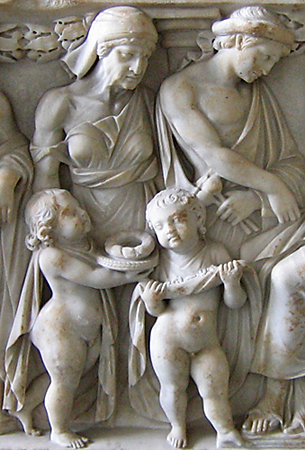 Nurse with Medea's children
Nurse with Medea's children marble sarcophagus, 2nd century CE
 Nurse with Medea's children
Nurse with Medea's children Sabina was a slave during the 1st century CE in the prominent household of Servius Cornelius Dolabella Petronianus, a senator and co-consul with the Emperor Domitian in 86 CE. Sabina was a nutrix to the filiusfamilias, Servius Cornelius Dolabella Metilianus, either because custom dictated that a senatorial family would employ a wet nurse for a newborn child or a surrogate was necessary for his birth mother due to her physical or emotional weakness after labor (see Gellius on breastfeeding, Soranus on nurses) -- it is also possible that Metilianus' delivery resulted in the not uncommon death of his mother Metilia (citizen women's names). Sabina herself would have been lactating after the birth of her own child, whom she may have continued to nurse or lost, given the high mortality rate for Roman children of all classes. Her child’s father was possibly a fellow slave in the elder Dolabella’s household with whom she had some kind of a relationship (see contubernales, as marriage between slaves was not legal). It is not evident what Sabina’s duties were after her charge was old enough to be turned over to a tutor: she may have continued to serve as nutrix for other children in the household or performed general tasks typical of female slaves within a large familia, such as cleaning, weaving, serving in some domestic capacity. Sabina's name, "the Sabine woman," is not a typical slave name (see slave names). Rather than an indication of her birthplace in the Sabine region, her name suggests a link to the gens Metilia, whose paterfamilias was the Roman senator Publius Metilius Sabinus Nepos (consul suffectus in 91 CE). Sabina may have been brought to the Dolabella home as part of her mistress's dowry when Metilia married Petronianus. While her lot was undoubtedly better than that of slaves who served outside the villa, she was still a slave, with little personal freedom or choice in her duties or relationships. At some point in her life Sabina was officially manumitted by her dominus (father or son: see freed names); there is no record of when this occurred, but her manumission may not have required her to leave the Dolabella household. Sabina's dedication was found near the fifth milestone on the Via Ardeatina in the ager Romanus southwest of Rome, suggesting that Metilianus maintained his childhood nurse in his villa suburbana until her death. The epitaph is seen as evidence that their relationship was a continuous and affectionate one. The full formal name of Sabina's nursling, who became consul suffectus in 113 CE, can be found in an honorary inscription (CIL 9.3154) awarded him as patron by the municipium of Corfinium (see also CIL 9.3152). Sabina's epitaph was transcribed from a funerary marker which was lost soon after its discovery and published in 1842 (CIL 6.16450). For further information about nutrices, see Soranus; also, Bradley, Dixon, Laes & Vuolanto, Rawson (1986, 2003) in the Bibliography.
SER[viae] • CORNELIAE • SER[vi] • L[ibertae]
SABINAE
SER[vius] • CORNELIVS
NVTRICI • ET • MAMMVL[ae]
Click on the underlined words for translation aids and commentary, which will appear in a small window.